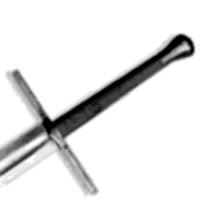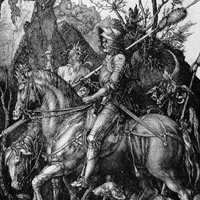- A warm up, focused on joint mobility in preparation for wielding a sword;
- Unpartnered drills - including stepping, guards, cuts and transitions;
- Partnered drills with the sword; and,
- Strength and conditioning exercises.
German Longsword study group located in
Port Macquarie NSW Australia
Welcome
About Our Group
Contact Us
Please use the Blog Archive panel, located on the lower right, to navigate our site.
Wednesday, 23 July 2008
What happens in a training session?
Friday, 11 July 2008
The Appeal of Historic Swordsmanship
While many enjoy the sword from an aesthetic viewpoint, some take it a step further and engage in martial practice.
Putting aside the elements of self-defence and physical fitness, a common thread runs through all martial arts – rather than just being something to pass the time, they can be pursued as a way of furthering ourselves mentally and emotionally, and can even become a focus to enhance our spirituality.
So, why do people choose the Historical European Martial Arts, or even more specifically, medieval swordsmanship?
The pull of the sword – an innate interest in edged weaponry may lead us to view the sword as a potent symbol or elegant weapon.
The pull of the times – we may have an interest in medieval history, re-enactment, or the myths of old, where the sword often features strongly.
The pull of the unknown – we might view the reconstruction of these arts as a great puzzle, enjoying the research and study, and recreating a part of our collective history.
We can appreciate the appeal of historical swordsmanship from a romantic perspective, but we must always remember to respect the sword. In its time it was an efficient, versatile and deadly tool, and that is no less true today, even when we are employing blunts or wasters.
The exact reason why anyone chooses this as a martial pursuit will likely involve more than one specific motive, but its position as a practical and historically based method for employing the longsword will continue to arouse interest for generations to come.
Sunday, 6 July 2008
First Contact
I urge you to take 2 minutes and 21 seconds out of your day to watch and enjoy it, even if you've seen it before.
The most common misconceptions are that employing the longsword was merely a matter of using strength to bash sword on sword, or that medieval swordsmanship was brutish and without any discernible heritage, refinement of technique, or finesse.
Another misconception involves the weight of medieval swords, which will be mentioned in an upcoming post.
- Brock, for Vier Leger
Friday, 4 July 2008
Fechtschule Sankt Peter
During June 2008 I was honoured to attend classes on the basics of the German Longsword as taught by Andrew Brew of Stoccata School of Defense.
Andrew teaches German Longsword and Polish Sabre at his Fechtschule Sankt Peter, located in Pymble NSW Australia.
As a beginner entering his school, I found his approach and teaching style both engaging and accomodating. The sessions were logical and practical, doing away with much of the pomp and ceremony that I have experienced in other martial arts.
Andrew is very approachable, with a visible enthusiasm for historical combat, and a deep knowledge of not only the German tradition, but many of the traditions within the Historical European Martial Arts.
Safety was a key concern during the sessions, with all participants working to their own level with a variety of swords, both wasters and blunts. After engaging in ordered progressions of individual and partnered drills, I watched as the advanced students engaged in free-play at differing speeds.
The school was populated by friendly and sincere students, who were happy to share their time and knowledge and trade strikes with a beginner. I felt very welcome and learned a great deal during my short stay.
If you are in the greater Sydney area and you're interested in the German Longsword, I heartily recommend that you get along to Fechtschule Sankt Peter and try a class. I'll definately be back!
For more information on attending a session at Fechtschule Sankt Peter, please visit the Stoccata site here.
- Brock, for Vier Leger
Wednesday, 2 July 2008
Wasters as Art
The wasters are made of a single piece of high-density plastic with a clear-vinyl-sheathed metal cross. They will be used both for those beginning their training with us, and also as a great training analogue for our steel blades in pell-work and other drills and applications.
These wasters are practical works of art - not only do they have a remarkably sure and springy feel, they are great to look at too!
I've been interested in edged weapons (swords in particular) for as long as I can remember. It's only been in recent years, however, that I've been able to realize my long held dream of actually learning how to properly use them.


Thanks again to Jeffrey for his efforts in creating these amazing wasters. Jeffrey really went "above and beyond" in getting these to us - and we just can't thank him enough! They are a fine and welcome addition to our collection of training weapons.
Tuesday, 1 July 2008
The Manuals of the Masters
A few of these manuals are text only treatises, while others are well illustrated; each of them must be translated before they can be used by the average English-speaking enthusiast, and a growing number of modern authors offer interpretations of the images and descriptions found within these works.
Free access to many source works and commentaries can be found online when one knows what one is looking for. An accessible and centrally located selection has been provided to the public courtesy of the ARMA at the Armarium.
However, the source texts may seem inaccessible to the beginning student.
For those unable to attend formal instruction, or wishing to start a study group, a number of modern authors have offered published training guides to the many armed and unarmed fighting arts comprising the Historical European Martial Arts.
One such guide, which outlines the use of the German Longsword and is based upon the texts and commentaries of what is commonly known as the Liechtenauer tradition, can be found in C. H. Tobler's book Fighting with the German Longsword.
A little searching online will turn up other approaches to structuring your training. Many different interpretations of the source works exist, with variance from school to school, and practitioner to practitioner. Often the interpretations used by any one person will change over time, reflecting their study and practice, and their communication with other practitioners.
Truly, however you interpret the manuals, it is the manner in which you and your partners approach your own study and training, and how you conduct youselves in your interactions with other practitioners, that will determine the outcome of your efforts. The values of respect, sincerity and camaraderie can be appreciated by all.
The rich and exciting legacy of the historical martial arts has been preserved through the Manuals of the Masters. By approaching these works honestly and earnestly, we do honour to our ancestors' efforts in preserving them.







